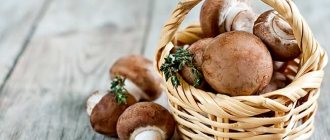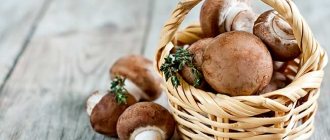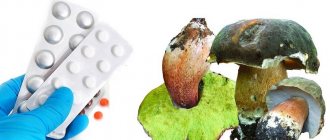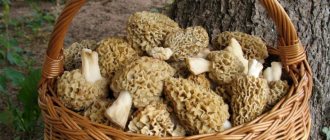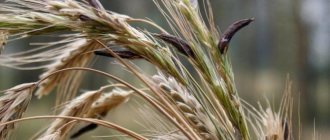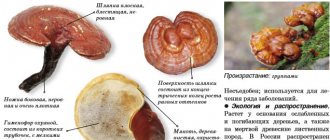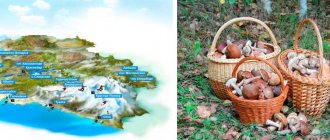Winter is definitely not the best time to pick mushrooms. And what kind of mushrooms can we talk about, you ask, if there is snow everywhere and the air temperature has dropped below zero Celsius? I hope this article will provide you with the most complete answer to this question.
The vast majority of the mushroom kingdom is inactive in winter. During frosts, you most likely won’t be able to find any mushrooms in the forest, with the possible exception of chaga, but we’ll talk about that a little later. However, there are species that grow during periods when the temperature ranges from 0 to +5 degrees. Most often, such “winter thaws” occur in December, when autumn is already behind us and winter is just beginning to gain strength. It is at this time that the forest can please you with the last mushrooms of the outgoing year.
Gifts under the snow
In the popular perception, it seems self-evident that mushroom picking is an exclusively spring-summer activity, with a small extension to early autumn. And, in part, this is true - most types of edible mushrooms grow during this period. However, there is no emptiness in nature, and some types of mushrooms continue to grow successfully even in cold winters, in severe frosts and under a cap of snow. Naturally, there are few such species, but they exist, giving the most convinced luminaries of quiet hunting the opportunity to go there even in winter.
Among the mushrooms that populate our winter forests we will find the legendary Winter Honey Mushrooms, Oyster Mushrooms, several types of polypores and mycenae, and collecting them under snow-covered trees is often even easier than in summer - the underbrush and abundance of greenery do not interfere.
How to cut oyster mushrooms correctly
They bear fruit in large conglomerates, fused with fruiting bodies. It is recommended to cut them with a sharp knife, being careful not to damage the rhizome. You need to remove everything at once, even if there are small specimens in the bunch: if you leave the small ones, they will die anyway.
You should take mushrooms whose caps do not exceed 10 cm in size: these are most suitable for eating because they have a delicate structure, unlike older specimens.
It is better to leave wet fruit bodies as they will begin to rot very quickly.
Some people advise eating only the caps, and cutting off the hard stems and discarding them. But experienced mushroom pickers believe that they should be used. The fact is that the legs require longer heat treatment. You can make delicious soup, caviar or sauce from them.
Important! For cooking, you need to take only the stems of young mushrooms. It is better not to use old ones, since they have lost their aroma and taste and do not soften when cooked, but become rubbery.
What mushrooms can be found in the winter forest
Firstly, in early winter, autumn species of mushrooms continue to bear fruit in the forest, especially if the autumn was warm enough. Therefore, under the deposits of the first snow you can easily find several types of rows, autumn honey fungus, yellow sulfur tinder fungus and many other inhabitants of the autumn forest. Theoretically, with a gradual decrease in temperature, autumn mushrooms can bear fruit for a long time in the December forest - they are quite capable of surviving slight frosts, but they cannot tolerate winter temperature fluctuations and, after the first thaw, they will become limp, after which there is no point in collecting them.
Winter mushrooms are not afraid of temperature fluctuations and the change from thaw to frost, and do not lose their qualities and nutritional value. Of course, they will not grow in severe frosts, but at the first thaw, they will instantly begin to grow, delighting lovers of quiet winter hunting with their scatterings.
When and how to collect winter mushrooms?
Collection time is October-November. Mushrooms do not yet have time to freeze and contain a full range of beneficial properties of this type of product. The deadline is set at the beginning of December, before the snow falls in a thick layer. All winter mushrooms are clearly visible among the fallen trees or on the white snow cover.
Different types of late mushrooms require a separate approach to collection. For cutting you will need:
- an ordinary kitchen knife (for honey mushrooms, oyster mushrooms, auricularia);
- a hatchet for removing chaga or tinder fungus from the trunk.
Hygrophor is freely removed from the substrate without the use of improvised means. The action does not harm the mycelium.
Winter mushroom picking is a great opportunity to spend time outdoors. In addition, winter representatives of their species will be quick to prepare. Many of them do not require pre-treatment.
0
0
Copy link
Oyster mushroom Pleurotus ostreatus
This famous and very tasty tree mushroom perfectly tolerates negative temperatures, so it is easily found in our forests until mid-winter. Like chaga, it is even easier to collect in winter, when tree trunks are not covered with leaves, and, by their characteristic shell-shaped shape, oyster mushroom is always easy to recognize. Oyster mushrooms are one of the most popular cultivated mushrooms in the world and are produced artificially in huge quantities every year, but it is so rewarding to find this mushroom during your own forest searches.
Oyster mushrooms always live on the trunk in small groups, preferring birch and aspen, and their caps are colored yellowish, brownish, bluish or light gray. Theoretically, they can be confused with polypores, but polypores are always much harder to the touch and have a different stalk shape.
Useful properties of mushrooms
When oyster mushrooms are grown in ecologically clean regions, the fruiting bodies do not accumulate toxins and heavy metal salts, therefore they have a good taste and healthy composition.
Despite the low calorie content, the product contains a large amount of protein (about 2.5%), vitamins (B, C, E, D and PP), as well as minerals and amino acids necessary for humans.
- The rich chemical composition determines the following beneficial properties of oyster mushroom dishes:
- lowering blood cholesterol levels;
- high nutritional value without harm to the figure;
- rapid absorption of the product by the body;
- strengthening the immune system;
- prevention of tumor development;
- cleansing the body of toxins;
- normalization of blood pressure;
- prevention of atherosclerosis.
Did you know? In Europe, oyster mushrooms began to be eaten en masse during the First World War, using them as an alternative to meat.
Despite the large list of positive qualities, dishes made from oyster mushroom are not recommended for children under 5 years of age , elderly people and those who have diseases of the gastrointestinal tract, kidneys or liver. This is explained by the fact that oyster mushrooms contain chitin, which is poorly absorbed by the human body and is not completely destroyed even after heat treatment.
It is recommended to eat oyster mushrooms no more than 2 times a week, since an excessive amount of this product is poorly absorbed by the body and can cause digestive upset.
Winter honey fungus Flammulina velutipes
This wonderful mushroom is one of the most important inhabitants of the winter forest, growing until spring on stumps or weakened trees, easily tolerating frosts and instantly growing during thaws.
The winter honey mushroom has a yellow-orange cap and a long, stiff leg covered with light down. It prefers to grow on aspen, elm, poplar and willow, but can be found on a variety of other trees.
Winter mushrooms are very tasty and suitable for preparing many wonderful dishes, and in Asia they are also used as a medicine for various diseases, including even cancer. Usually only the caps are used for food, but the youngest mushrooms can be eaten whole.
How to find which trees and stumps grow on
Like most other types of mushrooms, oyster mushrooms can settle in deciduous and mixed forests located in the temperate climate zone. These mushrooms are found throughout Europe and North America, as well as in Australia, Russia, Egypt, Sudan, India and Pakistan.
But you need to look for them not in the grass, but on the surface of the tree , since the oyster mushroom is a saprophyte, its nutrition comes from wood sap. At the same time, science claims that it can be found extremely rarely on coniferous trees.
Oyster mushrooms are usually found on trunks and located high above the ground. Mushrooms grow on top of each other in entire colonies, often have one common base and can create a multi-tiered structure on the bark. As a result of their appearance, the wood begins to literally collapse.
Oyster mushrooms grow on dead wood, as well as on stumps, fallen trunks, old and damaged trees:
- birch;
- aspen;
- Linden;
- hornbeam;
- willow;
- oak;
- alder;
- Rowan;
- poplar;
- chestnut;
- pine.
Find out also whether you can get poisoned by oyster mushrooms.
Hypholoma Capnoides
This species is also edible and very tasty. It grows on coniferous trees - stumps and dead wood, not only in winter, but also from spring to autumn. Its color varies from light brown to yellowish, depending on the degree of humidity. It usually grows in large clumps and is found infrequently, but in large quantities.
False honey mushrooms of this type do not differ in taste from other edible honey mushrooms and are suitable for any type of culinary use.
Growth factors
Oyster mushrooms require certain environmental conditions to grow successfully. In nature, the most favorable time for the development of these mushrooms is the first half of autumn.
In New Zealand, the cultivation and import of oyster mushrooms is prohibited by law - it is believed that this parasitic mushroom can harm local flora.
When growing oyster mushrooms on a personal plot, you need to take into account the following factors that influence the fruiting of the mycelium:
- stable air temperature - active growth of oyster mushrooms occurs at +17...+20 °C, and some winter varieties can bear fruit even at +5...+10 °C;
- air humidity - should be about 70% throughout the entire development cycle, since in drier air the mycelium dries out quickly;
- illumination - oyster mushrooms need sunlight at the stage of formation of fruiting bodies, and the development of mycelium occurs best in the dark;
- quality of the substrate - mushrooms feed on rotting wood, so they grow well on rotten stumps and trunks, and at home you can use sawdust, chips and straw to grow them.
We recommend that you read our electronic magazine about growing mushrooms at home.
Auricularia ear-shaped Auricularia auricula
This famous tree mushroom, also known as Judas Ear, has a delicate, delicious pulp and is especially revered in Asian countries.
The fruiting body of the auricularia has the appearance of a characteristic gelatinous mass, shaped like a semicircle or auricle, and can reach a diameter of up to 10 cm.
The outer surface of the fruiting body is covered with small sparse hairs and is rough to the touch. The inner surface where the hymenophore is located, on the contrary, is glossy and darker than the outer one.
The color of the fruiting body largely depends on its age - from translucent or pinkish in young fruiting bodies, to dark red, even black, in mature ones. The color also darkens in wet weather.
The pulp of the auricularia is translucent and thin, has a gelatinous consistency without a distinct odor. As the fruiting body ages, it becomes harder and drier. When dried, the auricularia greatly decreases in size.
Where and when does it grow
Auricularia auriculata lives on severely weakened or dead trunks of deciduous trees, especially alder and elderberry. Prefers deciduous forests with high humidity. It can be found in groups or alone. Auricularia is widespread in the warm part of the northern temperate zone, living in areas from Western Europe to the Far East. In Russia it is usually found in the southern and eastern regions and grows from spring to early winter.
Auricularia is suitable for boiling and frying, used in salads and marinated with hot spices. Residents of southern Russia boil auricularia, then cut it into strips, mix it with Korean seasonings and get a delicious mushroom appetizer.
Auricularia is often dried for future use. Dried fruit bodies lose a lot in volume, but are stored for a long time, and after soaking they regain their volume.
List of edible mushrooms that grow in winter
Among winter mushrooms there are edible and conditionally edible representatives. Most of them are well known.
Winter honey fungus (Flammulina velutipes)
Winter honey fungus appears at the beginning of winter or at the end of autumn. In some cases, it persists even after the New Year. Young honey mushrooms have a bell-shaped cap; as they grow and develop, it straightens out and becomes flat. The diameter of the cap reaches from 2 cm to 8 cm. It can have a yellow-ocher or rusty-brown color. The plates are white or light ocher. The thin leg has a velvety texture and black color, its length is from 3 cm to 8 cm.
Winter honey fungus is an edible mushroom that appears either at the beginning of winter or at the end of autumn
Winter honey mushrooms grow in bunches among the trees. During thaws, they can be hidden under a layer of snow. It is convenient to look for a yellow cap on white snow.
They usually choose as a place of growth:
- linden;
- willow;
- maple;
- poplar;
- elm.
In rare cases, mushrooms of this species grow on oak, apple and pear trees. They are found on both forest and garden trees. They love the south side, so there are noticeably fewer of them on the north side.
In most cases, winter mushrooms grow on the south side
Before cooking, honey mushrooms need to be boiled, as they contain toxins that need to be eliminated. To remove harmful substances, you need to keep them in boiling water for 20 minutes. In addition to toxic components, winter honey mushrooms contain flammulin, which is used to treat cancer.
In the Far East, winter mushrooms are grown as a mushroom crop. They are used not only for food purposes, but also in pharmaceuticals and traditional medicine.
Oyster mushroom (Pleurotus ostreatus)
Late oyster mushroom is the most noticeable of all the mushrooms growing in the winter forest. They are often found on sale, so mushroom pickers quickly recognize them by their appearance. Sometimes they can be confused with polypores of the gray or whitish variety, but knowing one feature, this can be easily avoided: polypores always lack a stalk, while oyster mushrooms have a rather pronounced base.
The close-knit growth in groups also gives it a resemblance to the tinder fungus. Oyster mushrooms choose dead or fallen trees as their habitat. As a rule, these are aspen or birch trees. Many mushroom pickers claim that oyster mushrooms like to settle on poplars. It is not so common on other deciduous trees.
Oyster mushroom - the most common winter mushroom
The oyster mushroom has a side stalk with a smooth, expanding transition into the cap. The shape of the mushroom resembles a shell, so it is sometimes called a shell or oyster. Most often the cap is light gray in color, but sometimes bluish, yellowish and brownish representatives are found. The diameter of the cap reaches 10 cm. Due to the special structure of the stem, it is difficult to confuse the oyster mushroom with other varieties.
These mushrooms can be prepared in many ways. Whatever processing option is chosen, they must be boiled and drained before cooking. In cooking, only the caps of oyster mushrooms are usually used, and the hard stems are set aside. However, you can also cook these parts of the mushrooms by boiling them and passing them through a meat grinder or mixer.
Oyster mushrooms can be used to prepare many dishes for different tastes.
According to many people, fried oyster mushrooms have the best taste. Mushrooms straight from the winter forest, picked by hand, turn out to be tastier than store-bought ones or those sold at bazaars.
Late panellus (Panellus serotinus)
Panellus is often confused with oyster mushroom, although it has nothing in common with it. Panellus grows from September to December, as long as there are no severe frosts. For full growth, it requires a temperature of +3 to +8 °C. It is collected from stumps and dry trunks of deciduous trees. Old mushrooms are best left alone as they are too tough to eat. Most often, panellus is consumed fried, but it can also be pickled or pickled. Taste qualities are at a decent level.
Late panellus grows on stumps and dead wood of deciduous trees
Chaga (Inonotus obliquus)
Birch chaga is considered a particularly valuable mushroom prey during the winter season. It has large dimensions and a non-standard appearance, so it is unlikely to be confused with other types of mushrooms. The cap forms a large growth on the tree, the mass of which can be several kilograms. Grows on old birch trees in places where the bark is broken. Chaga grows tightly to the tree trunk, so to remove it you will need a large knife or even a special camping ax.
Birch chaga is a valuable mushroom, the main advantage of which is its pronounced antimicrobial and antiseptic properties.
This mushroom has strong antimicrobial properties. Substances included in the composition of birch chaga:
- strengthen the immune properties of the human body;
- activate the central nervous system;
- have a positive effect on metabolism.
Chaga is used to create medicines in conventional and traditional medicine.
Auricularia auricula-judae
Auricularia grows throughout the year. It is collected during the winter temperature rise and in early spring. This mushroom looks like a growth in the form of a brown cap. They usually settle on dry trees, but sometimes on living ones. As a rule, they choose elderberry and alder as their home, in some cases maple, ash or elm.
Auricularia auriculata grows on dead wood and on the branches of deciduous trees and shrubs
This mushroom has become widespread in Chinese cuisine. There they call it “black tree ear”, despite the fact that it only turns black when it dries. Soups and salads are prepared from it.
The taste of auricularia is not for everyone; not everyone will like the feel of it either.
Late hygrophorus (Hygrophorus hypothejus)
Hygrofor usually grows on the outskirts of a pine forest among young coniferous trees. Life time is from August to December. An unremarkable small mushroom forms a mycorrhizal relationship with the roots of the pine tree it happens to be next to. Very often boletus grows next to hygrophores.
Hygrophorus late grows in mixed forests next to linden and oak trees
The edible mushroom tastes especially good after roasting. It is not marinated and salted so often.
Hypholoma Capnoides
Compared to winter honey mushrooms, this mushroom is quite rare. The cap is brown or yellowish-gray, the plates are white-yellow when young and darken in old age to a grayish-blue tint. The sulphurous honey fungus has a poisonous counterpart - the sulfur-yellow honey mushroom. They differ in smell: the edible variety has a pleasant and delicate aroma, while poisonous mushrooms have a bitter and foul aroma. Gray-plated honey mushrooms cluster on the stumps of coniferous trees and dry standing trunks.
Seroplate false honey fungus - a rare winter mushroom
Hygrophorus Late Hygrophorus Hypothejus
This small fungus grows in mixed and coniferous forests, preferring proximity to pine, from early autumn to the first half of winter. It is not afraid of snow and frost, often hiding in large clusters in mosses.
The cap of the late hygrophore changes shape with age from flat to funnel-shaped with a small tubercle in the center. Its diameter can reach up to 5 cm. The color of the cap is yellow-brown, sometimes with an olive tint, and its surface is smooth and slimy. The leg is thin and long, often curved, up to 10 cm long, covered with mucus and colored yellowish. The pulp of this winter mushroom is light and does not have a pronounced taste or smell.
This winter mushroom is edible and quite tasty, therefore it is valued by connoisseurs of quiet winter hunting.
Winter mushrooms grow in snowy forests to the delight of enthusiastic collectors who, even in winter, do not want to give up their hobby and are ready to combine mushroom picking with a ski trip.
Why does the inside of saffron milk caps turn green after the last frost?
Sometimes after the last frost the inside of saffron milk caps turns green, why does this happen? Could this affect further cooking? Usually, novice mushroom pickers are scared by the greenish tint on the cut of a mushroom, but for saffron milk caps this is a common occurrence. They are very delicate, so even with the slightest touch on the plates the color turns green.
If the cold lasts for several days, then even under a layer of foliage the saffron milk caps begin to lose their natural color and even acquire a greenish tint. However, some are not afraid to pick these mushrooms. By adding garlic, as well as other spices and seasonings when preparing a dish, you can make up for the missing taste of wild mushrooms.
Although saffron milk caps are harvested both in summer and autumn, they still have a reputation as late mushrooms. Autumn saffron milk caps are stronger and much tastier than those collected in the summer.
